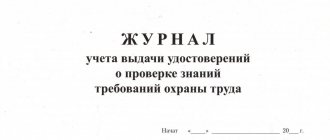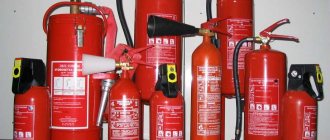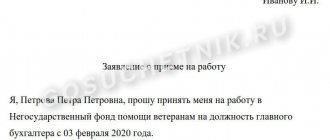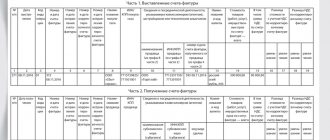What is a magazine for?
The number of various types of inspections carried out in organizations is only growing every year. The state exercises control over the financial side of the enterprise (including the tax component), document flow, compliance with sanitary, fire and other safety rules, etc. Over the course of a year, the number of visits by representatives of various types of supervisory structures in large companies can exceed a dozen. At the same time, inspections can be either planned, agreed upon in advance, or unscheduled, which, of course, unnerves the business to some extent.
FILES
The audit log has a very specific purpose: with its help, the organization’s management registers the fact of the control activity carried out, and also monitors the frequency of inspections by one or another state supervisory authority. The journal clearly structures the type and content of each inspection performed, records its duration, provides information about the department that carried it out, etc., and also provides the management of the inspected enterprise with an opportunity to briefly familiarize themselves with its initial results. And since the frequency of almost every type of inspection is enshrined in legislation, the excessive zeal of any regulatory authority with the help of this document can be challenged in the future.
Thus, thanks to the magazine, a company can not only systematize and properly plan its work, but also protect its interests.
Types of checks
Inspections of a legal entity are carried out by government agencies on the basis of the legislation of the Russian Federation.
There are two types of checks:
| Planned | The goal is to ensure that the enterprise or individual entrepreneur complies with the legislative norms and requirements established by federal and municipal regulations, including checking the compliance of the information provided with actual data. The verification is carried out on the basis of an order of the Prosecutor General's Office of the Russian Federation within the established time limits specified on the official website. The grounds for verification are:
|
| Unscheduled | The goal is to ensure compliance with federal and municipal laws, compliance with special requirements, including carrying out safety measures, training, liquidation of consequences of an accident or emergency, etc. The inspection does not have specific deadlines and is carried out as necessary. Government agencies are required to notify legal entities. person about the upcoming visit at least one day before the inspection. The grounds for verification are:
|
The inspection period in both cases cannot exceed 20 working days.
How to Journal
For the journal, there is a form approved at the legislative level that is recommended for use. You cannot make changes to it; in addition, it is undesirable to make any errors or inaccuracies when filling it out; all information must be accurate and reliable.
The journal is compiled in a single original copy, and it can be maintained both in live and electronic form. True, the electronic form, after final formation, must be printed so that the responsible employee of the organization and a representative of the controlling structure can put their signatures.
All sheets of the journal must be numbered in order and stitched.
The last page bears the company's seal (if any) and the signature of the responsible employee indicating the number of pages in the document.
Information about the journal must be entered into the nomenclature of files, and then transferred to the office department (or another engaged in similar functions) for safekeeping.
Recording digitized videotapes to disk
After the digitized video has been processed and converted into the required format, we record the finished video onto DVD discs. One DVD disc holds different amounts of digitized video material depending on the type of video. For example, a standard video in DVD-Video format, which will be played on absolutely any DVD player, takes up 4.7 Gigabytes, the duration of such a video will be a maximum of 70 minutes. This is the generally accepted global standard for recording DVD discs with the highest quality (HQ). Also, a digitized videotape can be recorded on a DVD disc as a file in Avi formats (using divx or xvid compression codecs). In this format, about 3 hours of digitized video fit on one 4.7 GB DVD.
It is especially worth noting that recording a digitized videotape onto a DVD is the most reliable way to preserve your memories. Information recorded on a DVD disc can be stored for decades if carefully stored and used. Not a single flash drive or hard drive will last that long.
Sample log of inspections of a legal entity
If you need to enter data into the audit log of a legal entity, and you have never done this before, look at a sample of filling out the document and read the explanations to it - with their help, you will probably easily do what is required of you.
- First of all, fill out the title page: enter here the start date of the journal (it may coincide with the date of the first inspection, which will be reflected in the form), then indicate the name of the organization - with a decoding of the organizational and legal status, its address, and the number of the state registration certificate.
- After this, be sure to mark the employee who is responsible for maintaining the journal, as well as information about the head of the company: his position, full name, then he must sign this part of the document.
- Next, go to the main section (one page is allocated for each check). Enter here the start and end dates of verification activities, the number of hours or days spent on verification.
- Indicate the name and number of the inspection authority, and also indicate the document on the basis of which its representatives act (usually this is some kind of order or instruction).
- Note the purpose and objectives of the inspection, information about the nature of the inspection: planned or unscheduled.
- Be sure to include in the journal information about the act that is written based on the results of each such event.
- If any violations were identified, indicate them briefly (the details are usually recorded directly in the report), also indicate information about the order to eliminate the violations, if one was issued.
- In conclusion, the form must include information about the employee of the supervisory agency who carried out the inspection, as well as experts, if any were involved in it, and they must put their signatures on the document.
What it is
Legal audit log. persons or individual entrepreneurs - a special document that allows you to record and analyze information about scheduled or unscheduled inspections carried out by government services.
The log is necessary to store all information about violations and to take measures to prevent these violations.
The timing and necessity of inspections is established by law. In this regard, the magazine allows you to protect the interests of an entrepreneur if any government agency pays undue attention to the enterprise.
The person responsible for maintaining the journal is appointed by the head of the organization.
It could be:
- CEO;
- secretary;
- lawyer;
- another company specialist vested with these powers.
Inspection bodies and regulatory agencies also enter information into the journal. Responsibility for the safety of the document lies not only with the authorized person, but also with the head of the enterprise or individual entrepreneur.
The need to keep a journal is not established by law. This means that organizations have the right not to make records.
However, such a decision may negatively affect the further functioning of the enterprise. In particular, it will be more difficult to prove the excessive attention of a particular inspector without documentary evidence.
If the company does keep an accounting log, then the regulatory authorities cannot refuse to make an appropriate entry about the inspection. In case of refusal, the head of the enterprise must contact the supervisors of the inspectors, and then go to court if a compromise cannot be reached.
Registration of results
The act of the approved form is drawn up in 2 copies : one ─ to the inspector, the other ─ to the individual entrepreneur or the head of the enterprise. Information in the act includes:
- Date, time and place of its registration.
- Name of the state supervision authority.
- Date and number of the order ─ grounds for inspection .
- Full name and position of each specialist who took part in the on-site control.
- Name of the legal entity or full name of the entrepreneur present during the control procedure.
- Day, time, place of supervision.
- Data on the results of the inspection , including the nature of the violations found and the persons responsible for the shortcomings.
- Information regarding familiarization (refusal) with the act, including their signature or refusal to do so.
- Controllers' signatures.
Additions to the act in the form of acts of product sampling, environmental studies, expert reports, explanations from company employees and other materials relevant to the case.
Legal entities and individual entrepreneurs must have a Control Activities Log , where inspectors make entries about each inspection. This book is drawn up according to the approved template (it can be understood from the form).
Note! Federal Law N 134-F3 “On the protection of the rights of legal entities and individual entrepreneurs during state control” is not related to the implementation of:
- tax, currency and budget control;
- banking and insurance supervision;
- transport control (checkpoints when crossing the border of the Russian Federation);
- control of port administrations by airport aviation inspection on the territory of ports;
- state supervision of traffic safety, compliance with sanitary and epidemiological standards in railway transport;
- customs control;
- safety control in nuclear energy;
- supervision over ensuring the storage of state secrets;
- sanitary and quarantine control at Russian border crossing points;
- control of facilities recognized as dangerous under the laws of the Russian Federation, important sensitive facilities indicated in the list approved by the Government of the Russian Federation;
- operational-search measures, inquiry, investigation, prosecutorial supervision and justice;
- metrological and construction supervision.
Who fills it out?
The first filling required by the audit log is always directly related to document verification. Simply put, from determining its belonging to a specific enterprise or organization. For legal entities, this is the signature of the manager and the seal of the company. For individual entrepreneurs, according to the law, only a handwritten painting is sufficient. In addition, you will have to number the pages, stitch them, and then indicate the final number on the title page.
There is no need to fill out any fields in the main section. This is done exclusively by inspection persons, who indicate the date, time, and purpose of the inspection.
The mandatory storage period for the document is 5 years. After this time, you can not write off the audit log to the archive, but destroy it.
Results
To successfully run any business, an entrepreneur always needs to keep the situation under control. A log of inspection activities is necessary, first of all, for the manager himself to protect his rights, because a complaint about control organizations exceeding their powers must be documented.
In accordance with the law, all organizations and individual entrepreneurs operating on the territory of the Russian Federation are required to have a log of inspections carried out by regulatory authorities . Federal bodies authorized by the government of the Russian Federation have developed a standard form for this document and rules for filling it out.
administrative penalties for the absence of an inspection log at the enterprise, but supervisors will definitely note this fact in the inspection report with an order to eliminate the shortcomings.
What are the benefits of having a legal journal? face?
The audit log of legal entities is not only a tool for interaction with representatives of various authorities. It may well work for the benefit of the enterprise or organization itself, especially in cases where a representative of the inspection or a fraudster posing as him tries to commit illegal actions.
According to the law, scheduled business inspections today are carried out strictly according to schedule. Unscheduled - with mandatory warning to all interested parties and in the presence of the owner/manager. Apart from these two reasons for a visit, no other arguments should simply exist. If an “inspector” visits an organization with an inspection unscheduled or without warning, making an entry in the journal will be a good reason to confirm the fact of violation of legal norms. In most cases, the usual offer to fill out a document in its entirety becomes the last one in communication with such amateur “inspectors.”
It is important to know that it is the presence of an audit log that gives a legal entity the basis to demand compliance with the legality of all actions taken in relation to it. If the document is missing, this can be taken advantage of by scammers or officials who simply decide to find a source of additional income.












